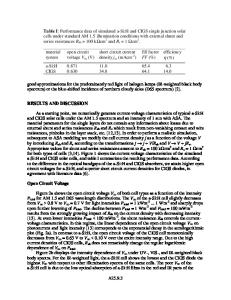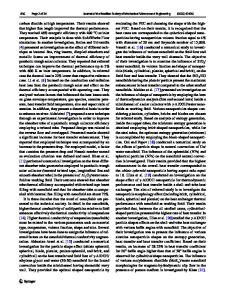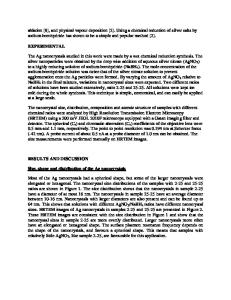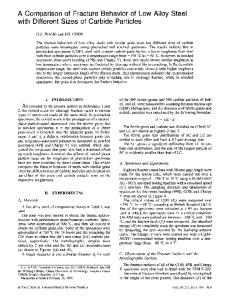Characterization of Dye-Sensitized Solar Cell with Different Nanoparticle sizes
- PDF / 253,114 Bytes
- 7 Pages / 432 x 648 pts Page_size
- 43 Downloads / 270 Views
Characterization of Dye-Sensitized Solar Cell with Different Nanoparticle sizes Aung Htun, Lakshmi V. Munukutla, Sailaja Radhakrishnan, Chih Y. Jen, Arunachalanadar M. Kannan and Karthik Kinhal Arizona State University, Department of Engineering Technology, 6075 S. Williams Campus Loop, TECH Building, Mesa, AZ 85212, U.S.A. ABSTRACT The Dye-sensitized Solar Cell (DSSC) has been regarded as the next-generation solar cell because of its simple and low cost fabrication process. The experiments for optimizing the cell efficiency were carried out in this work include varying the TiO2 layer thickness on the working electrode and determining the most favorable nanoparticle size in the TiO2 paste. The TiO2 electrode or working electrode was fabricated using screen printing technique with the Coatema tool with thicknesses ranging from ~20 to 66 μm. It was observed that both open circuit voltage and short circuit current were found to have measurable dependence on the TiO2 layer thickness. The open circuit voltage changed from 0.77 to 0.82 V and correspondingly the short circuit current also varied from ~19 to 23 mA/cm2 depending on the TiO2 layer thickness. Additionally, the cell with 40 μm TiO2 thickness showed 9.06% photo conversion efficiency compared to 6.4% and 8.5% efficiency obtained for the cells with 20 μm and 66 μm TiO2 thicknesses respectively. The second part of the experiment was conducted using three different nanoparticle sizes of 13 nm, 20 nm and 37nm in the TiO2 layer to identify optimum nanoparticle size by maintaining the TiO2 film thickness at 40 μm. The cell with 20 nm size nanoparticle, in combination with 40 μm TiO2 thickness showed 11.2% efficiency that is in par or slightly better than the efficiency value reported for the DSSC in the literature as of now. The work described in this paper showed best possible values for the TiO2 layer thickness and nanoparticle size in the TiO2 for obtaining improved cell efficiency of 11.2%. INTRODUCTION The emergence of electric potential between two electrodes attached to a solid or liquid system upon light irradiation has been discovered by Edmond Becquerel in 1839 and is ever since known as the photovoltaic effect [1]. This discovery has been the base for a variety of concepts to convert solar radiation into electricity and has opened a new domain of alternative energy generation. Michael Grätzel first introduced the Dye-Sensitized Solar Cell (DSSC) in 1991 based on the concept of the photovoltaic effect [2]. DSSCs are treated as promising candidates for the next generation (third generation) of solar cells due to their low cost fabrication and high-energy conversion performance. A DSSC comprises of a working electrode made of dye-sensitized TiO2 nanoparticles fabricated on a transparent conducting oxide (TCO), a Pt counter electrode, and an electrolyte containing iodide/trididode (I-/I3-) redox couple [3]. The photo conversion efficiency of the DSSC is significantly dependent on the quality of TiO2 electrode, hence it is important to optimize the thickness of T
Data Loading...











